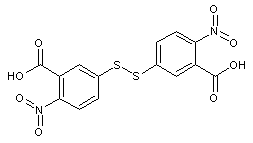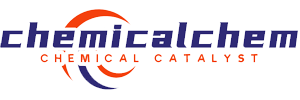
structural formula
| business number | 01ft |
|---|---|
| molecular formula | c14h8n2o8s2 |
| molecular weight | 396.35 |
| label |
5,5’dithiobis(2-nitrobenzoic acid), 6,6′-dinitro-3,3′-dithiobenzoic acid, 3-carboxy-4-nitrophenyl disulfide, 6,6′-dinitro-3,3′-dithiodibenzoic acid, bis(3-carboxy-4-nitrophenyl)disulfide, dtnb, ellman’s reagent, [-sc6h3(no2)co2h]2, enzymes·proteins·peptides |
numbering system
cas number:69-78-3
mdl number:mfcd00007140
einecs number:200-714-4
rtecs number:dg9650000
brn number:1896821
pubchem number:24894189
physical property data
1. character:off-white or yellow powder.
2. density (g/ml,25/4℃): unsure
3. relative vapor density (g/ml ,air=1): unsure
4. melting point (ºc):240-245 (dec.)(lit.)
5. boiling point (ºc,normal pressure): uncertain
6. boiling point (ºc, 5.2kpa): unsure
7. refractive index:not sure
8. flash point (ºc): unsure
9. specific optical rotation (º): unsure
10. autoignition point or ignition temperature (ºc): unsure
11. vapor pressure (kpa,25ºc): unsure
12. saturated vapor pressure (kpa,60ºc): unsure
13. heat of combustion (kj/mol): unsure
14. critical temperature (ºc): unsure
15. critical pressure (kpa): unsure
16. oil and water (octanol/log value of water) partition coefficient: uncertain
17. explosion limit (%,v/v): unsure
18. lower explosion limit (%,v/v): unsure
19. solubility: slightly soluble in acetic acid and water .
toxicological data
acute toxicity: mouse abdominal ld50: 2080 mg/kg;
ecological data
none
molecular structure data
none
compute chemical data
1. reference value for hydrophobic parameter calculation (xlogp): 2.7
2. number of hydrogen bond donors: 2
3. number of hydrogen bond acceptors: 10
4. number of rotatable chemical bonds: 5
5. number of tautomers: none
6. topological molecule polar surface area 217
7. number of heavy atoms: 26
8. surface charge: 0
9. complexity: 528
10. number of isotope atoms: 0
11. determine the number of atomic stereocenters: 0
12. uncertain number of atomic stereocenters: 0
13. determine the number of chemical bond stereocenters: 0
14. number of uncertain chemical bond stereocenters: 0
15. number of covalent bond units: 1
properties and stability
none
storage method
this product should be sealed and stored in a cool, dry place.
synthesis method
none
purpose
for biochemical research. determination of sulfhydryl groups. monitoring of organophosphorus pesticide poisoning (cholinesterase assay).
eft; mso-list: l0 level1 lfo1; tab-stops: list 36.0pt; mso-pagination: wi-orphan; mso-margin-top-alt: auto; mso-margin-bottom-alt: auto” align=left> 17. explosion limit (%,v/v): unsure
18. lower explosion limit (%,v/v): unsure
19. solubility: slightly soluble in acetic acid and water .
toxicological data
acute toxicity: mouse abdominal ld50: 2080 mg/kg;
ecological data
none
molecular structure data
none
compute chemical data
1. reference value for hydrophobic parameter calculation (xlogp): 2.7
2. number of hydrogen bond donors: 2
3. number of hydrogen bond acceptors: 10
4. number of rotatable chemical bonds: 5
5. number of tautomers: none
6. topological molecule polar surface area 217
7. number of heavy atoms: 26
8. surface charge: 0
9. complexity: 528
10. number of isotope atoms: 0
11. determine the number of atomic stereocenters: 0
12. uncertain number of atomic stereocenters: 0
13. determine the number of chemical bond stereocenters: 0
14. number of uncertain chemical bond stereocenters: 0
15. number of covalent bond units: 1
properties and stability
none
storage method
this product should be sealed and stored in a cool, dry place.
synthesis method
none
purpose
for biochemical research. determination of sulfhydryl groups. monitoring of organophosphorus pesticide poisoning (cholinesterase assay).
mso-ascii-font-family: arial; mso-hansi-font-family: arial; mso-font-kerning: 0pt; mso-bidi-font-family: arial”>for biochemical research. determination of thiol groups. monitoring of organophosphorus pesticide poisoning (cholinesterase assay).

 微信扫一扫打赏
微信扫一扫打赏

